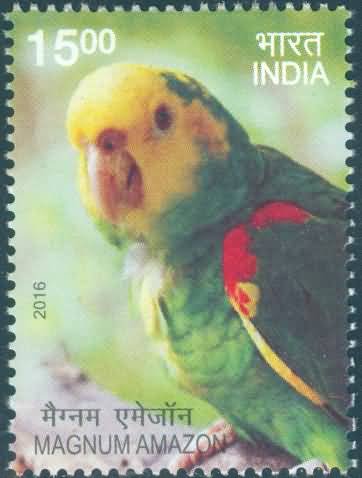Magnum Amazon

Technical Data
| Stamp Set | Exotic Birds |
|---|---|
| Date of Issue | December 5, 2016 |
| Denomination | Rs. 15 |
| Quantity | 200,000 |
| Perforation | 13¾ |
| Printer | Security Printing Press, Hyderabad |
| Printing Process | Wet Offset |
| Watermark | No Watermark |
| Colors | Multicolor |
| Credit (Designed By) | Smt. Alka Sharma |
| Catalog Codes |
Michel IN 3029A Yvert et Tellier IN 2736 Stanley Gibbons IN 3199 |
| Themes | Animals (Fauna) | Birds | Parrots |
A Majestic and Powerful Parrot of the Tropical Americas
(Commemorative Postage Stamp)
The Magnum Amazon, a distinguished member of the Amazon parrot group, represents the grandeur, colour, and charisma that define the avifauna of Central and South America. Loved for its intelligence, expressive behaviour, and striking plumage, this species is a symbol of the lush tropical forests it inhabits.
Distinctive Appearance
- The Magnum Amazon is a stocky, medium-to-large parrot with a commanding presence and a robust bill typical of Amazon parrots.
- Its plumage is predominantly brilliant green, complemented by brightly coloured patches on the forehead, wings, and tail, depending on the subspecies.
- Mature individuals display intense facial coloration, often involving vivid yellows, reds, or blues, making them easily recognizable.
Habitat & Distribution
- This species inhabits tropical rainforests, mangroves, riverine woodlands, and forest edges across its native range in Mexico, Central America, and northern South America.
- It prefers areas with abundant fruiting trees and secure nesting cavities, often selecting large, mature trees for roosting and breeding.
Behaviour & Ecology
- Like many Amazon parrots, the Magnum Amazon is known for its exceptional vocal abilities, producing a range of loud calls and whistles.
- Highly social, it typically gathers in flocks—especially around dawn and dusk—creating vibrant spectacles in forest canopies.
- Its diet includes fruits, seeds, berries, nuts, and blossoms, making it an important agent of forest regeneration through seed dispersal.
Threats & Conservation Status
- Many Amazon parrot species, including the Magnum Amazon, face serious threats:
- Habitat destruction from logging and agricultural expansion
- Poaching for the pet trade, driven by their reputation as outstanding mimics
- Declining nesting sites due to loss of large trees
- Several Amazon species are listed as Endangered or Vulnerable on the IUCN Red List and included in CITES Appendix I, ensuring strong international protections.
Cultural Significance
- For centuries, indigenous communities of the Amazon basin have revered these parrots for their intelligence and symbolism.
- Their ability to mimic speech and bond strongly with humans has made them highly sought-after companions, contributing to their cultural visibility worldwide.
A Tribute Through Philately
This commemorative postage stamp celebrates the Magnum Amazon as an icon of tropical biodiversity. Its vibrant colours, spirited personality, and ecological importance make it a fitting ambassador for conservation. Through this stamp issue, the Department of Posts highlights the urgency of protecting the magnificent Amazon parrots that enrich both nature and human culture.
